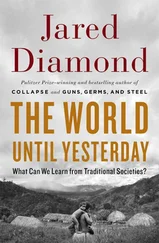Jared Diamond - Guns, Germs & Steel
Здесь есть возможность читать онлайн «Jared Diamond - Guns, Germs & Steel» весь текст электронной книги совершенно бесплатно (целиком полную версию без сокращений). В некоторых случаях можно слушать аудио, скачать через торрент в формате fb2 и присутствует краткое содержание. Жанр: 105. Описание произведения, (предисловие) а так же отзывы посетителей доступны на портале библиотеки ЛибКат.
- Название:Guns, Germs & Steel
- Автор:
- Жанр:
- Год:неизвестен
- ISBN:нет данных
- Рейтинг книги:5 / 5. Голосов: 1
-
Избранное:Добавить в избранное
- Отзывы:
-
Ваша оценка:
- 100
- 1
- 2
- 3
- 4
- 5
Guns, Germs & Steel: краткое содержание, описание и аннотация
Предлагаем к чтению аннотацию, описание, краткое содержание или предисловие (зависит от того, что написал сам автор книги «Guns, Germs & Steel»). Если вы не нашли необходимую информацию о книге — напишите в комментариях, мы постараемся отыскать её.
Guns, Germs & Steel — читать онлайн бесплатно полную книгу (весь текст) целиком
Ниже представлен текст книги, разбитый по страницам. Система сохранения места последней прочитанной страницы, позволяет с удобством читать онлайн бесплатно книгу «Guns, Germs & Steel», без необходимости каждый раз заново искать на чём Вы остановились. Поставьте закладку, и сможете в любой момент перейти на страницу, на которой закончили чтение.
Интервал:
Закладка:
FURTHER READINGS • 437
translation in the Loeb Classical Library edition note 17); Albert Ammerman and L. L. Cavalli-Sforza, The Neolithic Transition and the Genetics of Populations in Europe (Princeton: Princeton University Press, 1984), analyzing the spread of food production from the Fertile Crescent westward across Europe; Graeme Barker, Prehistoric Fanning in Europe (Cambridge: Cambridge University Press 1985), and Alasdair Whittle, Neolithic Europe: A Survey (Cambridge: Cambridge University Press, 1985), for Europe; Donald Henry, from Foraging to Agriculture: The Levant at the End of the Ice Age (Philadelphia: University of Pennsylvania Press, 1989), for the lands bordering the eastern shore of the Mediterranean; and D. E. Yen, "Domestication: Lessons from New Guinea," pp. 558-69 in Andrew Pawley, ed., Man and a Half (Auckland: Polynesian Society, 1991), for New Guinea. Edward Schafer, The Golden Peaches of Samarkand (Berkeley: University of California Press, 1963), describes the animals, plants, and other things imported into China during the T'ang dynasty.
The following are accounts of plant domestication and crops in specific parts of the world. For Europe and the Fertile Crescent: Willem van Zeist et al., eds., Progress in Old World Falaeoethnobotany (Rotterdam: Bal-kema, 1991), and Jane Renfrew, Paleoethnobotany (London: Methuen, 1973). For the Harappan civilization of the Indus Valley, and for the Indian subcontinent in general: Steven Weber, Plants and Harappan Subsistence (New Delhi: American Institute of Indian Studies, 1991). For New World crops: Charles Heiser, Jr., "New perspectives on the origin and evolution of New World domesticated plants: Summary," Economic Botany 44(3 suppl.):! 11-16 (1990), and the same author's "Origins of some cultivated New World plants," Annual Reviews of Ecology and Systematics 10:309-26 (1979). For a Mexican site that may document the transition from hunting-gathering to early agriculture in Mesoamerica: Kent Flan-nery, ed., Guild Naquitz (New York: Academic Press, 1986). For an account of crops grown in the Andes during Inca times, and their potential uses today: National Research Council, Lost Crops of the Incas (Washington, D.C.: National Academy Press, 1989). For plant domestication in the eastern and / or southwestern United States: Bruce Smith "Origins of agriculture in eastern North America," Science 246:1566-71 (1989); William Keegan, ed., Emergent Horticultural Economies of the Eastern Woodlands (Carbondale: Southern Illinois University, 1987); Richard Ford, ed., Pre- tstonc Food Production in North America (Ann Arbor: University of
4 3 8 " FURTHER READINGS
Michigan Museum of Anthropology, 1985); and R. G. Matson, The Ori gins of Southwestern Agriculture (Tucson: University of Arizona Press, 1991). Bruce Smith, "The origins of agriculture in the Americas," Evolu tionary Anthropology 3:174-84 (1995), discusses the revisionist view, based on accelerator mass spectrometry dating of very small plant samples, that the origins of agriculture in the Americas were much more recent than previously believed.
The following are accounts of animal domestication and livestock in specific parts of the world. For central and eastern Europe: S. Bok6nyi, History of Domestic Mammals in Central and Eastern Europe (Budapest: Akademiai Kiado, 1974). For Africa: Andrew Smith, Pastoralism in Africa (London: Hurst, 1992). For the Andes: Elizabeth Wing, "Domestication of Andean mammals," pp. 246-64 in F. Vuilleumier and M. Monasterio, eds., High Altitude Tropical Biogeography (Oxford: Oxford University Press, 1986).
References on specific important crops include the following. Thomas Sodestrom et al., eds,, Grass Systematics and Evolution (Washington, D.C.: Smithsonian Institution Press, 1987), is a comprehensive multi-author account of grasses, the plant group that gave rise to our cereals, now the world's most important crops. Hugh Iltis, "From teosinte to maize: The catastrophic sexual transmutation," Science 222:886-94 (1983), gives an account of the drastic changes in reproductive biology involved in the evolution of corn from teosinte, its wild ancestor. Yan Wenming, "China's earliest rice agricultural remains," Indo-Pacific Prehis tory Association Bulletin 10:118-26 (1991), discusses early rice domestication in South China. Two books by Charles Heiser, Jr., are popular accounts of particular crops: The Sunflower (Norman: University of Oklahoma Press, 1976) and The Gourd Book (Norman: University of Oklahoma Press, 1979).
Many papers or books are devoted to accounts of particular domesticated animal species. R. T. Loftus et al., "Evidence for two independent domestications of cattle," Proceedings of the National Academy of Sci~ ences U.S.A. 91:2757-61 (1994), uses evidence from mitochondrial DNA to demonstrate that cattle were domesticated independently in western Eurasia and in the Indian subcontinent. For horses: Juliet Glutton-Brock, Horse Power (Cambridge: Harvard University Press, 1992), Richard Meadow and Hans-Peter Uerpmann, eds., Equids in the Ancient World (Wiesbaden: Reichert, 1986), Matthew J. Kust, Man and Horse in History
FURTHER READINGS • 439
(Alexandria, Va.: Plutarch Press, 1983), and Robin Law, The Horse in West African History (Oxford: Oxford University Press, 1980). For pigs: Colin Groves, Ancestors for the Pigs: Taxonomy and Phylogeny of the Genus Sus (Technical Bulletin no. 3, Department of Prehistory, Research School of Pacific Studies, Australian National University note 18). For llamas: Kent Flannery, Joyce Marcus, and Robert Reynolds, The Flocks of the Wamani (San Diego: Academic Press, 1989). For dogs: Stanley Olsen, Origins of the Domestic Dog (Tucson: University of Arizona Press, 1985). John Varner and Jeannette Varner, Dogs of the Conquest (Norman: University of Oklahoma Press, 1983), describes the Spaniards' use of dogs as military weapons to kill Indians during the Spanish conquests of the Amer-icas. Clive Spinnage, The Natural History of Antelopes (New York: Facts on File, 1986), gives an account of the biology of antelopes, and hence a starting point for trying to understand why none of these seemingly obvious candidates for domestication was actually domesticated. Derek Good-win, Domestic Birds (London: Museum Press, 1965), summarizes the bird species that have been domesticated, and R. A. Donkin, The Muscovy Duck Cairina moschata domestica (Rotterdam: Balkema, 1989), discusses one of the sole two bird species domesticated in the New World.
Finally, the complexities of calibrating radiocarbon dates are discussed by G. W. Pearson, "How to cope with calibration," Antiquity 61:98-103 (1987), R. E. Taylor, eds., Radiocarbon after Four Decades: An Interdisci plinary Perspective (New York: Springer, 1992), M. Stuiver et al., "Calibration," Radiocarbon 35:1-244 (1993), S. Bowman "Using radiocarbon: An update," Antiquity 68:838-43 (1994), and R. E. Taylor, M. Stuiver, and C. Vance Haynes, Jr., "Calibration of the Late Pleistocene radiocarbon time scale: Clovis and Folsom age estimates," Antiquity vol. 70 (1996).
Chapter 11
For a gripping account of the impact of disease on a human population, nothing can match Thucydides' account of the plague of Athens, in book
of his Peloponnesian War (available in many translations).
1 hree classic accounts of disease in history are Hans Zinsser, Rats, Lice, and History (Boston: Little, Brown, 1935), Geddes Smith, A Plague on Us (New York: Commonwealth Fund, 1941), and William McNeill, Plagues
Интервал:
Закладка:
Похожие книги на «Guns, Germs & Steel»
Представляем Вашему вниманию похожие книги на «Guns, Germs & Steel» списком для выбора. Мы отобрали схожую по названию и смыслу литературу в надежде предоставить читателям больше вариантов отыскать новые, интересные, ещё непрочитанные произведения.
Обсуждение, отзывы о книге «Guns, Germs & Steel» и просто собственные мнения читателей. Оставьте ваши комментарии, напишите, что Вы думаете о произведении, его смысле или главных героях. Укажите что конкретно понравилось, а что нет, и почему Вы так считаете.










